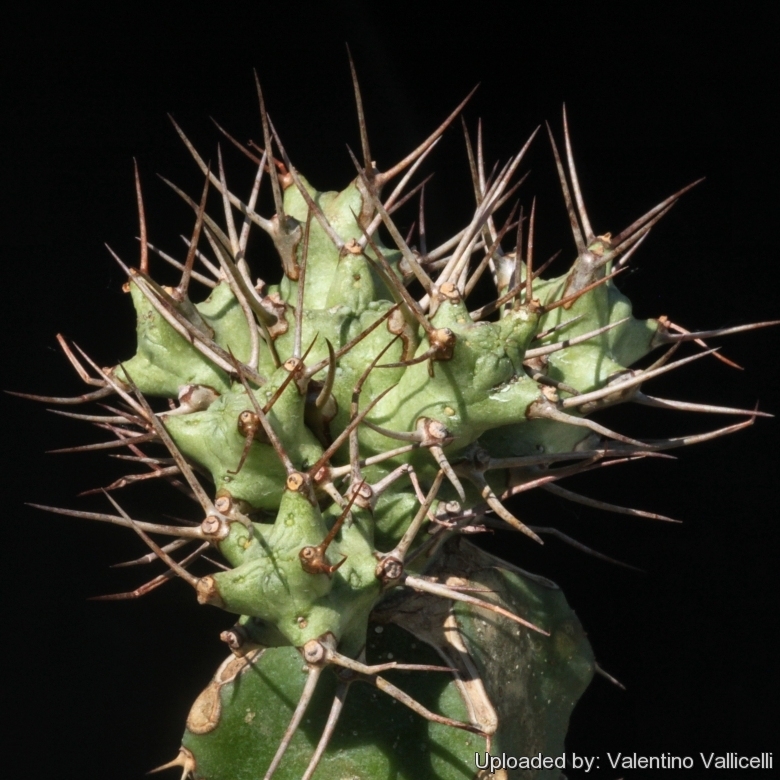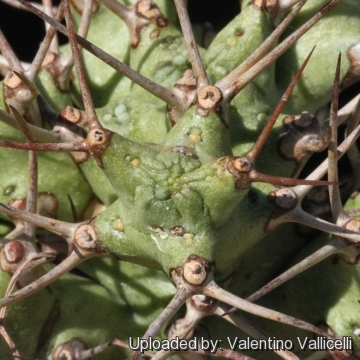
Euphorbia atrox Photo by: Valentino Vallicelli
Origin and Habitat: Somalia.
Altitude range: 90–550 m.
Habitat: Grows on rocky limestone slopes in open areas scatter with xerophytic Commiphora shubs and other succulents like Cyphostemma betiformis, Caralluma huernioides and Ceropegia sp.
Synonyms:
Description: It is a spiny perennial succulent that froms small conical shrubs up to 30 cm tall and 40 cm in diameter.
Stem: Branches are 15-25 mm in diameter, short and re-branching, covered with raised tubercles arranged in 5 series.
Roots: Fibrous.
Spine shieds: Oblong 5-10 mm long, 2-3.5 mm wide, quite distanced, covering the entire apex of the tubercles.
Spines: Stout up to 25 mm long.
Stipular spines: Vestigial, but evident on seedling plants.
Inflorescences: 1 to 3 cymes immediately above the spine-shields in a vertical line, developing successively,1-forked, with peduncle and cyme-branches 1 mm long.
Flowers: Cyathia 3.5 mm in diameter, orange-yellow. Nectar glands 2 mm broad, touching, orange-yellow. Styles 1.5 mm long
Fruit: 2,7 x 3,.7 mm wide 3-lobed with truncate base capsule exserted on a recurved pedicel up to 4 mm long
Seeds: Ovoid, 2 x 1.5 mm, minutely and closely tuberculate.
 Euphorbia atrox Photo by: Valentino Vallicelli
Euphorbia atrox Photo by: Valentino VallicelliSend a photo of this plant.The gallery now contains thousands of pictures, however it is possible to do even more. We are, of course, seeking photos of species not yet shown in the gallery but not only that, we are also looking for better pictures than those already present.
Read More... Cultivation and Propagation: This specie has the fame to be quite tricky to cultivate. A very light and warm place in full sun is highly appreciated. It does best in a mineral soil, good drainage is essential. Water sparingly during the summer months and keep dry in winter. In the short growing season it likes ample water and in this period it grows rather quickly, though not for a long time. When not in growth it is killed right away, when given too much water. It is a slow growing long lived plant and once established, it will be content in its position and with its soil for years. It can tolerate moderate shade, and a plant that has been growing in shade should be slowly hardened off before placing it in full sun as the plant will be severely scorched if moved too suddenly from shade into sun.
Frost Tolerance: Tender, it needs frost protection. Recommended minimum temperature is 12 °C or even above.
Propagation: It is propagated from seed sown during spring or summer. Sowing seed of this species is the surest method of growing typical offspring and seedlings are in the first season relatively easy to grow but as seedlings age they are very difficult to keep alive.
It can be reproduced by cuttings or grafting.
Grafting: The plants that are grafted on a more vigorous and easier stocks are easier to keep alive, grow faster and produce more flowers and seeds. The method of grafting euphorbias differs little from that of other succulents, except in one important aspect. The latex must be washed or sprayed off until hardly anything remains. After the latex flow has stopped, a further 1-2 mm slice can be taken from both surfaces without a new latex flow starting. Both scion and stock need to be at the start of the growing season. The stock should be cut as near as possible to the growing tip, as here the vascular bundles are dense and not yet woody and will feed the scion in the best possible way. Where possible stock and scion should be of similar diameter. The cut surfaces are held together with elastic bands in cross style, over the plant top and under the pot. The plants should be left in an airy and shady place for 7-10 days before the bands are removed.
Warning: As with all other Euphorbias when a plant get damaged it exudes a thick white milky sap known as latex. This latex is poisonous and particularly dangerous for the eyes, skin and mucous membranes. So pay extreme attention not to get any in your eyes or mouth. Cultivated plants must be handled carefully.












